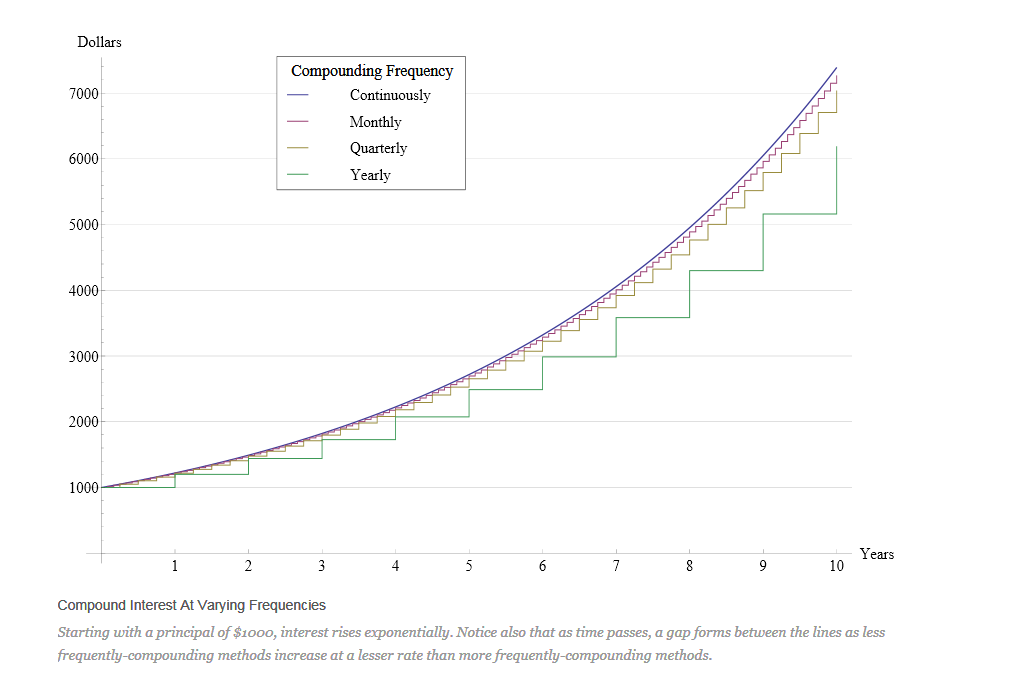2.1 Exponential and Logarithmic Function Applications
Pre-Class:
- Take notes on the videos and readings (use the space below).
- Work and check problem #1 in the 2.1 NOTES section.
- Complete the 2.1 Pre-Class Quiz.
Introduction
Exponential functions occur frequently in science and business and are commonly used in compound interest applications.
- The value of a \$1000 investment returning 8% interest compounded monthly after 12 years would
be calculated using the formula $$A=P\left(1+\frac rn\right)^{nt},$$
where:
- A is the final amount in the account.
- P is the principal.
- r is the interest rate.
- n is the number of compounding periods per year.
- t is the number of years.
- The compounding frequency has a significant impact on the final amount of money (either
saved or owed).

Notes
Compounding Frequency
- Yearly: $$A=1000(1+\frac{.08}1)^1=1080$$
- Quarterly: $$A=1000(1+\frac{.08}4)^4=1082.43$$
- Monthly: $$A=1000(1+\frac{.08}{12})^{12}=1083$$
- Daily: $$A=1000(1+\frac{.08}{365})^{365}=1083.28$$
- Continuously (at every instant): $$A=1000 \cdot~\underset{n\to \infty }{\mathop{\lim }}\,{{\left( 1+\frac{.08}{n} \right)}^{n}} =1083.29$$
Our focus will be on continuous compounding:
- What is e?
- Irrational number (similar to $\pi $ )
- 2.718281828459…..
- Like $\pi $, e occurs frequently in natural phenomena
- Growth of bacterial cultures
- Decay of a radioactive substance
- Formal definition of e: $$e=~\underset{n\to \infty }{\mathop{\lim }}\,{{\left( 1+\frac{1}{n} \right)}^{n}}$$ $$\approx ~~2.718281829$$
Notes
Continuous Compounding Formula (appreciation and depreciation): $$A = P{e^{rt}}$$
CONTINUOUS COMPOUND INTEREST: Round all answers to two decimal places.
-
Hometown Bank offers a CD that earns 1.58% compounded continuously. If \$10,000 is invested in this CD, how much will it be worth in 3 years?
$A = 10,000{e^{.0158(3)}}$
$A = \$ 10,485.41$
The account will be worth approximately \$$10,485.41$ in three years.
-
Hometown Bank offers a CD that earns 1.58% compounded continuously. If \$10,000 is invested in this CD, how long will it take the account to be worth $11,000?
$11,000 = 10,000{e^{.0158t}}$
$\frac{{11,000}}{{10,000}} = \frac{{10,000{e^{.0158t}}}}{{10,000}}$
$\frac{{11}}{{10}} = {e^{.0158t}}$
$\ln \frac{{11}}{{10}} = \ln {e^{.0158t}}$
$\ln \frac{{11}}{{10}} = .0158t$
$\frac{{\ln \frac{{11}}{{10}}}}{{.0158}} = \frac{{.0158t}}{{.0158}}$
$6.03 = t$
It will take approximately 6.03 years for the account to be worth $11,000.
-
Doubling Time: How long will it take money to double if it is invested at 5% compounded continuously?
$A = P{e^{rt}}$
$2 = 1{e^{.05t}}$
$2 = {e^{0.05t}}$
$\ln 2 = \ln {e^{0.05t}}$
$\ln 2 = 0.05t$
$\frac{{\ln 2}}{{0.05}} = t$
$t = 13.86$
It will take approximately 13.86 years for the initial investment to double.
-
Doubling Rate: At what nominal rate compounded continuously must money be invested to double in 8 years?
$A = P{e^{rt}}$
$2 = 1{e^{r(8)}}$
$2 = {e^{8r}}$
$\ln 2 = \ln {e^{8r}}$
$\ln 2 = 8r$
$\frac{{\ln 2}}{8} = r$
$0.0866 = r$
In order for the initial investment to double in 8 years, the money must be invested in an account with a nominal rate of approximately 8.7% compounded continuously.
-
How long will it take money to triple if it is invested at 10.5% compounded continuously?
$A = P{e^{rt}}$
$3 = 1{e^{.105t}}$
$\ln 3 = \ln {e^{.105t}}$
$\ln 3 = .105t$
$\frac{{\ln 3}}{{.105}} = t$
$10.46=t$
It will take approximately 10.46 years for the initial investment to triple.
-
Radioactive Decay: A mathematical model for the decay of radioactive substances is given by $$Q = {Q_0}\;{e^{rt}}.$$ The continuous compound rate of decay of carbon-14 per year is $r = -0.0001238.$ How long will it take a certain amount of carbon-14 to decay to half the original amount?
$\frac{1}{2} = 1{e^{ - 0.0001238t}}$
$\ln .5 = \ln {e^{ - 0.0001238t}}$
$\ln .5 = - 0.0001238t$
$\frac{{\ln .5}}{{ - 0.000128}} = t$
$t = 5598.93$
It will take approximately 5598.93 years for the carbon-14 to decay to half the original amount.
-
The estimated resale value R (in dollars) of a company car after t years is given by: $$R(t) = 20000{(0.86)^t}.$$ What will be the resale value of the car after 2 years? How long will it take the car to depreciate to half the original value?
$R(2) = 20,000{(0.86)^2} = \$ 14,792$
The resale value of the car after two years will be $14.792.
$\frac{{10,000}}{{20,000}} = \frac{{20,000{{(0.86)}^t}}}{{20,000}}$
$.5 = {0.86^t}$
$\ln .5 = \ln {0.86^t}$
$\ln .5 = t\ln 0.86$
$\frac{{\ln .5}}{{\ln 0.86}} = \frac{{t\ln 0.86}}{{\ln 0.86}}$
$\frac{{\ln .5}}{{\ln 0.86}} = t$
$t = 4.5957$
It will take approximately 4.6 years for the car to depreciate to half its original value.